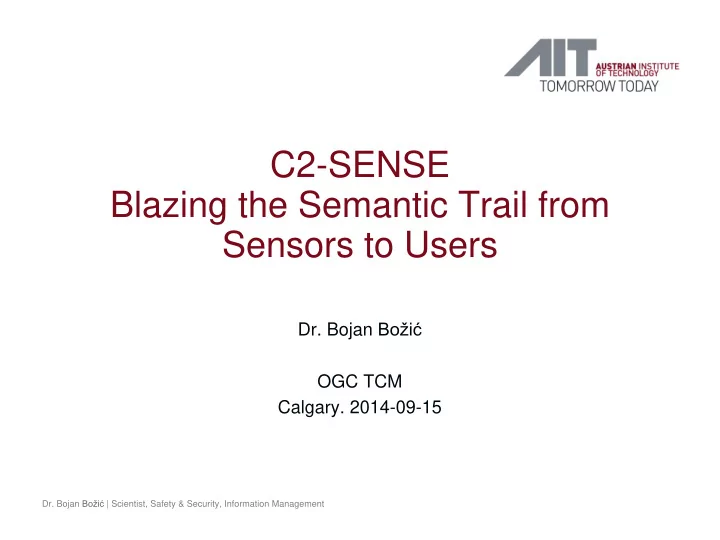

C2-SENSE Blazing the Semantic Trail from Sensors to Users Dr. Bojan Božić OGC TCM Calgary. 2014-09-15 Dr. Bojan Božić | Scientist, Safety & Security, Information Management
Team: Crisis and Disaster Management Crisis management for improved action and preparedness Model crisis scenarios and consequences, Simulate alternative impacts Make strategic decisions & Optimize deployment of resources Reference Projects: CRISMA, SUDPLAN Driving Innovation in crisis management information systems Improving the information flow between citizens, volunteers, first responder and crises managers Information storage and interagency information sharing Reference projects: DRIVER , Re-ACTA, EPISECC, C2-SENSE Sensor Systems and Semantic Web for environmental monitoring Technologies and Systems for Information transport between sensors and decision support systems Environmental measurement networks and data provision Reference projects: emikat, (open)uwedat, Carbotraf, TaToo, SANY 2
C2-SENSE Interoperability Profiles for Command/Control Systems and Sensors Systems in Emergency Management
Context Collaborative capability project Scope: provide mechanisms for interoperability between command & control and sensors Market focus: civil security, civil protection, emergency management and day-to-day monitoring Application: large range of services
Objectives Propose an interoperability framework for heterogeneous networks composed of sensors and control centres via protocol profiles for crisis management and a service oriented architecture Demonstrate the framework concept Propose standards (for the interoperability and interoperability certification methodology) Case study and prototyping: application to crisis management and sensor networks of Apulia region in Italy
Members SAGEM DEFENSE France Project Coordinator SECURITE Data / Object model interoperability. LUTECH Italy Protocol interoperability . Software integration. Austrian Institute of Austria Specification. Knowledge interoperability . Technology Standardization activities. SRDC Turkey Information interoperability . Profiles integration. Certification and testing mechanisms. Pilot application – requirements and validation. Servizio Protezione Civile Italy Regione Puglia Pilot application – design and deployment. InnovaPuglia Italy Industrial Research Poland Organizational and physical interoperability. Institute for Automation and Measurements REGOLA Italy Harmonized doctrines. Validation. 6
Standards collection , Methodology procedures, BR, Organizational Technical ontology… High Level Objectives Harmonized Strategy/Doctrines Specialisation and demonstration on Aligned Operations Apulia use case Aligned Procedures Knowledge Information Interoperability Data/Object Model Interoperability Profiles specification Protocol Interoperability Implementation Physical Interoperability Certification methodology Standards proposal 7
Emergency Interoperability Framework Emergency Domain Inventory: created by surveying existing standards, real life use cases of sensors, devices, C2 systems, and emergency management, architecture for different scenarios. Emergency Domain Ontology: common, modular, and focused ontology with all stakeholders’ knowledge in a unique, flexible data model; development of mechanisms for interoperability of different standards in the emergency domain; based on well-accepted and commonly used standards in emergency management, command and control, and sensor domains. Emergency Interoperability Profiles: enable effective exchange of information among different rescue units, public safety units and information systems without requiring any special technical a priori arrangements; functional and operational requirements as well as cultural, linguistic, and legal issues. 20.01.2016 8
Global Framework 9
Standardization In the scope of C2-SENSE, with the Emergency Interoperability Profiles being the standard artifacts, necessary standardization activities will be initiated to evolve C2-SENSE Emergency Interoperability Framework into a standard specification for interoperability between Sensor Systems and C2 Systems , with the aim of helping the development of a European market in this field. C2-SENSE is an ambitious project but the infrastructure to be developed will be based on open source software and existing standards . This will facilitate the development efforts and will help easily identify gaps, where new technological solutions, guidelines, recommendations or standards are needed, at each level of the interoperability stack . 20.01.2016 10
Knowledge Interoperability Common operational picture of the crisis situation and the support of collaboration for joint decision making Emergency Profile Definition Language Development of Knowledge Interoperability Profiles with tools such as: Collaboration Environment • Emergency Maps Tool • Sensor Management Tool • Messaging/Communication Platform • Registry of Emergency Web Services • Profile Repository, Monitoring and Definition Tool GIS Server 20.01.2016 12
Data/Object Model, Information, and Knowledge Layers Data/Object Model Layer: HL7, XML, Web Services KML Processing: Java API for KML, PythonKML GML Processing: GML Parser for Java, GML4J, AppForMap OGC SWE Implementation: Java API for OGC SWE, OGC Utils NewsML Processing: NewsML Toolkit Information Layer: OWL-DL Reasoner: Jena, Pellet OWL Parsing: Jena OWL Parser, OWL API, Python OWL Knowledge Layer: GIS Server : GeoServer, MapServer Mash-up: Open Layers Collaboration Tool 20.01.2016 13
Emergency Interoperability Profiles Template Initial activities Control structure Data flow structure Resources Objective: Managing a crisis situation to prevent chaotic responses In the event of a crisis, the appropriate scenario is selected and customized to specific organizations and specific incidents Aligned procedures and operations Harmonization of procedures and operations supported through service level agreements 20.01.2016 14
Person/Patient Objects in Different Standards 20.01.2016 15
Semantic Interoperability Framework 20.01.2016 16
Knowledge Interoperability Layer Components 20.01.2016 17
Contact DR. BOJAN BOŽIĆ Scientist Safety & Security Information Management AIT Austrian Institute of Technology GmbH Donau-City-Strasse 1 | 1210 Vienna | Austria M +43 664 2351800 bojan.bozic@ait.ac.at | http://www.ait.ac.at 19
Recommend
More recommend